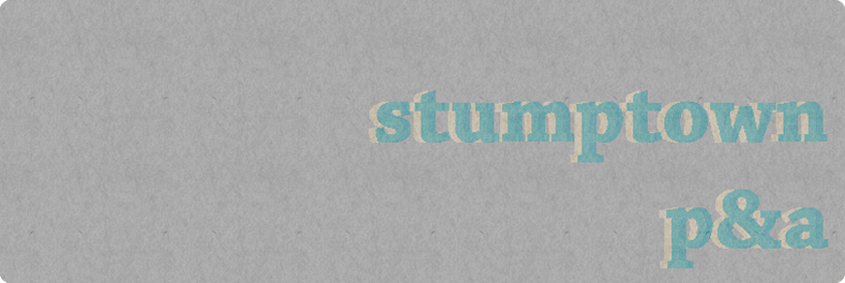 Since taking over as the Communications Director for PICA, I've spent a lot of time considering the future of journalism and the prospects of print. Until recently, print media was our sole venue for advertising and editorial coverage, but that fact has changed rapidly. Where it gets tricky is that print hasn't yet been wholly eclipsed by digital technologies; rather, the two mediums have to coexist in a tenuous shared existence. They're not so much neighbors as reluctant co-owners of the same house, each waiting for the other to sell off their share. In considering the merits of each, I have to admit that I've fallen on both sides of the debate equally often.
Since taking over as the Communications Director for PICA, I've spent a lot of time considering the future of journalism and the prospects of print. Until recently, print media was our sole venue for advertising and editorial coverage, but that fact has changed rapidly. Where it gets tricky is that print hasn't yet been wholly eclipsed by digital technologies; rather, the two mediums have to coexist in a tenuous shared existence. They're not so much neighbors as reluctant co-owners of the same house, each waiting for the other to sell off their share. In considering the merits of each, I have to admit that I've fallen on both sides of the debate equally often.
I've often lamented the snarky tone and ADD brevity of the web, but I've also scorned the resistance of mainstream printed media to intelligently and unflinchingly re-assess their ailing industry. I'm speaking in broad strokes here, but where one medium has written itself into irrelevance by reporting staid news to an ever-shrinking audience (newspapers), the other medium has established an overly-democratic overabundance of shallow content (the internet). If you stop and look at the two outlets, then you come to realize that both in fact suffer from a similar flaw: a lack of well-considered news.
Now, that's not to say that you can't find good writing in both. Old standards like the New York Times continue to support incisive editorial writing and good columnists, and some blogs and websites offer analysis and reporting to rival the best of the traditional media. But part of the appeal (and shortcoming) of the internet is the openness; anyone can post their own take on the news without the oversight of fact checkers or editors. Sometimes this works, and sometimes this devolves into self-indulgence.
The issue (in my mind) is that as the internet has courted the market share traditionally held by newspapers, those papers have frantically tried to ape the qualities of the web - namely short, quick stories with little shelf life and a casual tone. Very infrequently has the internet tried to mimic newspapers. And why should they? They seem to be doing just fine as they are. But this begs the question: if the internet focuses mainly on up-to-the-second news and personal opinion - and newspapers try to follow this lead - then who is left to cover long-lead stories and in-depth investigative reporting? I have a hard time seeing the internet stepping up to fill this role.
I've spoken a few times with people about whether or not blogging encourages sloppy writing. The counterargument runs that the text is what matters, the rest is just container. To them, you could write a novel on a stack of post-it notes. But I think if you set out to write on post-it notes, you'd simply end up jotting down reminders. Humans suffer from a bias of "functional fixedness" - we're not, as a species, particularly good at imagining new uses for old tools. Once something works for a particular problem, what's the sense in shaking things up? There are many great writers throughout the span of the internet, but most people have trouble seeing the point in using the tool for anything other than gossip, banter, and infotainment. And even those who do see the point will have trouble finding any way to generate an income to fund good writing, good reporting, and investment in a news story.
But these are just musings. I don't have any answers about just how exactly newspapers will continue, or whether the internet will assume the many abandoned posts of traditional journalism. I think there is a great potential in both forms and have an unabashed love of each (for different reasons). But lingering on print for a moment, I have some hope for the future thanks to inspiring experiments like the McSweeney's Panorama.
I received a copy in the mail back in December and just finished reading it (all of it) last week. I can honestly say that I've never read that much of any single newspaper. I read the cover, the op-eds, the Book Review, the sports section, the arts coverage, the Sunday Magazine, the comics, and the food section. And I read a whole lot more that wouldn't easily fit into any previous newspaper I've ever seen.
But it wasn't a real newspaper; it was a one-off conceit of a literary magazine, an attractive daydream of what a newspaper could be. This is not to fault McSweeney's, just to acknowledge that the medium hasn't yet been revived. In truth, McSweeney's was probably the best possible outfit to attempt a project of this scope (320 pages! 150 contributors!). They have a breathless enthusiasm apparent in all of their ventures. Their approach is certainly infectious.
As I paged through each section on my first time looking at the paper, I kept interrupting A to exclaim at whatever new spread I held up in wonder. The whole experience felt like revisiting a childhood tradition. Lingering over a newspaper is one of those experiences that we sadly reserve today for those rare, lazy Sunday mornings. In reality, the experience of delving headlong into a newspaper should happen much more frequently.
The diversity of subjects is amazing. In the course of reading The Panorama, I read about DVD cover art, the environmental impact of Mendocino County marijuana operations, the 49ers, the Bay Bridge, lamb butchering, an out-of-print novel by an Irish author, and the reasons behind choosing public education for your child. Say what you will about the glories of the internet, but it strikes me that newspapers were the original form of rhizomatic learning, weaving an ever-deepening web of relationships, new leads, and wide-ranging (but interconnected) ideas.
Oh, and the design. What design! A large part of the pleasure of skimming the Panorama is sensory - 15 x 22" broadsheet pages with full-color, full-spread images. There are simply some things the internet (or, more accurately, a computer screen) can't approximate, and that is exactly the strength of McSweeney's newspaper gambit: to highlight the unique strengths of printed media. In-depth, lengthy stories; gorgeous design; immersive imagery. It would be a shame to lose these things to text-heavy, design-ignorant websites, but they already happen to be rare in newspapers. Perhaps this will serve as a wake-up call for newspapermen to embrace the limitations (and glories) of their medium.
I have a real fetish for printed objects: books, magazines, journals, daily and weekly newspapers. Let's hope The Panorama wasn't a last hurrah, but a rallying cry for creative explorations of the form.
Monday, February 15, 2010
the newspaper is dead, long live the newspaper.
Posted by
p
at
2:58 PM
0
comments
![]()
Labels: books, design, newspapers, san francisco, video
Saturday, January 9, 2010
the very best
Near the end of 2008, we sat down to outline a very selective and disjointed list of year-end favorites: tastes, sounds, reading materials, and good experiences. It was maybe a bit quirky, but it gave us a nice chance to reflect on our best discoveries from the year and set the tone for 2009. Then, just into January, we followed it up with a firm resolution for the New Year: live awesomely. Simply put, if 2008 was a year of learning self-sufficiency and DIY basics, then 2009 would be a year of looking at how our decisions impacted our community, and how we could live more happily with our choices. Out went chain-store shopping, in came considered purchases for things we truly loved. Out went disposables, in came quality.
All in all, it went pretty well for us. Apart from underwear, we largely avoided major retailers and focused our spending on local and independent businesses. When we went out to eat, we made sure we to visit restaurants we loved. I'm not going to suggest that we staved off the recession in Portland (maybe just a little), but I am proud to see how many good local shops and chefs made it through last year. Here were a few of our best finds that summed up our year:
Mc Sweeney's
After years of coveting, we got a subscription. Our first issue was a set of dystopian shorts set in 2034. Issue two arrived as a full Sunday-edition newspaper with a magazine and book review. They may not single-handedly solve the problems of the publishing industry, but they'll certainly keep my interest.
Ned Ludd
With a good friend working there from Day One, we had the chance to watch this little restaurant go through their entire first year. Wood-fired foods, farm-direct sourcing, and salvaged interiors make this the quintessential Portland restaurant for these times. The owners are awesome and generous folks and 100% deserve all of the love they've received.
Cabinet subscription
Year 2 and we're still in love. It's like the hipster Harper's.
Pendelton
Part of shifting away from IKEA obsolescence and into heirloom hand-me-down territory meant replacing our pill-ridden fleece throws with two beautiful wool blankets. Totally timeless. Also awesome? Their amazing collaborations with contemporary fashion companies. P loves his Opening Ceremony x Pendelton cardigan.
Rediscovering hamburgers
Seriously, where have you been all my life? Grass-fed beef done rare with bacon, carmelized onions, cheese, and pickles on a good bun. There's something totally illicit about pressing down on an over-loaded bun and letting the juices run together. I certainly wouldn't eat a burger just anywhere, but I think about them all the time.
Dirty Projectors
Favorite album and favorite concert of the year.
iPhone
Totally worth it. It's a little, futuristic joy that makes up for the childhood birthday when I didn't receive a Dick Tracy walkie-talkie watch.
Pork
A spur-of-the-moment decision to order a half hog from a local farm led us to buy a chest freezer, which led us to a lot of summer preserving. The payoff has been huge, so we upped our share to an entire pig for year 2. The Portugese have a saying that the two happiest times in life are just after marriage, and just after a pig slaughter.
Bryant Terry
It's maybe a bit odd to follow up 75 lbs of pork with a shout-out to a vegan chef, but Terry really was that cool. We brought him to town for a weekend with Slow Food, and completely fell in love with the guy. His dishes never front as anything other than what they are - no faux-meats or cheese substitutes - just flavorful, vegetable-packed, and Soul Food-inspired vittles.
Indian cooking
The spices showed up after our visit to Montreal, but were only really put to work when we picked up a copy of Yamuna Devi's Lord Krishna's Cuisine. With freshly-ground masalas for every dish, our home-cooked dals and biryanis now rival most restaurants we've tried.
Edible Geography
Of all the blogs I follow, this one stands out among this year's discoveries. With recent posts on North Korean food propaganda, soil flavors, plant quarantines, and sexual kitchen puns in Vermeer's paintings, this site offers the intellectual balance to all of the wonky food policy sites and cutesty cooking blogs out there.
Lucky Strike
A far-flung restaurant that inspired a lingering obsession with Sichuan cooking and authentic Chinese food. Fiery-hot dry-fried chilies and the numbing, citrus electricity of prickly ash.
Pet pha lo from Ping
Thanks to our geeky obsession with Pok Pok, we earned an early bird invite to the preview dinner for their new restaurant. The stand-out dish? An aromatic, star anise-infused duck leg stew, paired with pickled mustard greens and a vinegary chili sauce. We've been back four times and have never missed a chance to order it.
Anything served in a glass (or on a plate) at Beaker and Flask
This place works some serious cocktail magic. The longer we spend time at the bars, the more and more we realize that the basics are always best. Martinis. Manhattans. Gin and Tonics. Stray too far from those drinks and you'll end up with a syrupy-sweet, pink-hued mess. And yet, Beaker and Flask nails every drink every time, using stonepine liquer, rare herbal tinctures, and more booze than is probably healthy. The cocktails are consistently unique and always balanced. Couple the bar with an amazing kitchen turning out dishes like grilled romaine salads, smoked mackarel, and pork cheeks with pickled octopus, and it's definitely one of the best new places to open in Portland.
Posted by
p
at
5:30 PM
0
comments
![]()
Labels: best of, portland, resolutions
Wednesday, November 4, 2009
bitte orca

FOR IMMEDIATE RELEASE: Dirty Projectors brought it to the Aladdin last night. Stylish folks with mind-blowing melodies and some crazy guitar work. We'll put that show in a small pantheon of epic concerts. Who else would be in there? Early Modest Mouse. Elliot Smith. The Magnetic Fields. Antony & The Johnsons. The Flaming Lips.
They're killer live and plugged in.
They're just as good acoustic.
There's a little Talking Heads, a little B-52s, a little Zeppelin in there. A little something else, too.
Humming and drumming my fingers on the desk all day.
First show in a while that we didn't want to end. The bastards kept us up past our bedtime. And we liked it.
- - - -
A MAN OF FEW WORDS: Dave Longstreth is big on musical chops. No time for stage banter. That's alright by our standards. Keep it short and simple and focus on the damn music. Our kind of man.
- - - -
FILE UNDER: ROCK OPERA'S NOT DEAD
An animated opera about a fictional Don Henley? Not a joke. Not even an exaggeration. Here's a taste.
- - - -
PLAYS WELL WITH OTHERS? I guess there are a few folks who'd like to work with the Projectors. Björk. David Byrne. Big names.
- - - -
REQUIRED VIEWING: The Projectors on Jimmy Fallon.
- - - -
HOCKETING: That's what you call that sound? 13th century monastic chorale music. Split melodies. Reminds me of singing Row Your Boat in rounds. Whatever the case - it is some crazy shit. The man himself explains it here.
- - - -
IMITATION IS THE HIGHEST FORM OF FLATTERY:
This post finds us in a DDC kind of mood. Good schtick. Good designers. Check 'em out.
- - - -
ON THE PLAYER:
01. Dirty Projectors - Bitte Orca
02. Dirty Projectors - Knotty Pine
03. Dirty Projectors - Mount Wittenberg Orca
Wednesday, October 7, 2009
ps

Through a summer of job transitions, art festivals, and over-extending ourselves with Slow Food, this blog has been pretty quiet. To get back into a rhythm, it's probably a good idea to look back, but, since I'm not overly ambitious, I won't be looking back very far.
Earlier this week, I walked over with a few of my co-workers to visit a pop-up publishing house. Publication Studio, the brainchild of Matthew Stadler and Patricia No, has squatted in the Ace Hotel Cleaners, where they are cranking out small-run novels and books. So far, they've published a catalog for a local gallery show, two short debut novels, and an annotated urban planning reader. When my work descended on the studio en masse, we bought them out of their day's printing of Lawerence Rinder's thinly-veiled fiction about his time as a curator at the Whitney. I guess working at an arts organization has made us predictable
It's true that I love a good book project, but I also love a good machine. To publish their on-demand books, the PS team has a high-speed duplex printer, a paper trimmer, and - to seal the deal - a perfect binder. I could watch this dreamy little video all day:
Publication Studio Makes A Book from Mike Merrill on Vimeo.
So far, I've been really impressed by what PS has released, and they already have exciting projects lined up through fall. In late October, they'll be participating in the 2009 Amsterdam Biennale, a decentralized art fair with satellite pavilions operating around the world. Portland's contingent will print a collection of single-run artist books, including some by two of my friends and co-workers. I'll certainly try to attend kick-off party on the 24th, with on-the-spot collaborative writing and early-morning gin. It's good to know that some (more creative) parts of the publishing industry still have a reason to celebrate.Friday, August 7, 2009
foragers
Couple a nationwide recession with a burgeoning food movement and you're bound to wind up with some foraging. Stylish foraging. News outlets have picked up on the trend (right behind the urban chicken coops craze), and they've raised its caché, even labeling it "the underground fruit economy." But these make-do tendencies have been around for a long time. Just think of old-school gleaners. Hell, foraging has even had indie cred for a long time.
Take LA's radical artist collective Fallen Fruit and their anarcho-ecological, Marxist guerrilla gardening. They started out by collecting the ignored produce of Los Angelenos' yards on nocturnal fruit walks, which have in turn become popular art scene happenings. The group recognized unused fruits and unplanted lots across the city, and have set out to expose the urban potential for food sovereignty.
Closer to home, Portland boasts the less-radical, but still exceptional Portland Fruit Tree Project and the community-generated wiki, Urban Edibles. The former is practically a fresh-fruit food bank, while the latter is much more DIY and under-the-radar. A and I have long thought about joining up on a Fruit Tree Project picking party or skipping the u-pick farm and gathering cherries on the streets. And yet, apart from some furtive handfuls of blackberries as we walk down an alley, we've always copped out.
-
I remember when we lived in Northwest Portland, I'd pass a Chinese couple in the mornings on my way to work. Both elderly, they'd be bent over collecting gigko nuts from the sidewalk. Others would pass by holding their noses against the sour odor of the trees, but the two people would stay crouched to the pavement with their bulging plastic bags. It was always jarring to see the two of them actually putting the wasted bounty to use.
-
Each year, A and I talk about all of the foods we'd like to experiment with preserving, usually after their seasons have passed. This summer, however, we had a seredipitous chance to both cross a new recipe off of our list and to scout out some neighborhood edibles. I can't remember when I'd first read about nocino, the Italian walnut liqueur, but something about it stuck with me. Ever since then, I've talked wistfully about tracking down green walnuts, but have never followed through. I'd thought this year's season had passed me by again, only to see a macerating jar of walnut fruits on the bar counter at Laurelhurst Market. While the tight-lipped bartender wouldn't reveal his walnut source, he did let us know that we probably had a few remaining days when the walnuts would still be soft enough to use.
That weekend, A and I fired up the Urban Edibles database and found a few clusters of trees in our neighborhood. On an early Saturday morning, we went out with grocery bags in hand and managed (after a lot of leaping and stretching) to knock down enough pounds of the hard green fruits to steep. We even found a few nut-bearing trees that we later added to the map.
At home, we chopped the nuts (which leak a thin liquid that stains everything it touches golden to green to inky black) and mixed them with a liter of cheap vodka according to David Lebovitz' simple recipe. The stuff smells high-test, and it's beginning to look potent; we have a few weeks left, and the brew already resembles motor oil. I suppose that's a fitting use for some walnuts we picked above our neighbor's parked cars.
Posted by
p
at
6:25 PM
0
comments
![]()
Thursday, July 16, 2009
cherry-pickin'
Last Saturday we woke up way-too-early for a way-too-cold-for-July morning adventure. Yet, in spite of our groggy protestations, we knew we'd made a good decision as soon as we arrived at Sherwood Orchards. We discovered the farm in mid-October of last year when I got an itch to make quince paste, but refused to pay the premium at the markets in-town. After a little research, we found this farm just down highway 99 that had a few rows of quince trees, along with dozens of varieties of heirloom apples. We picked boxes worth of fruit and went home happy, redolent of quince's potent and flowery aroma.
Following a few months off, Sherwood Orchards opened for this year's season at the beginning of July. And with that announcement, we returned in search of another hard-to-find fruit: pie cherries. Luckily, the fiery older couple that runs the farm have sour montmorency cherries in spades. Pie cherries are almost comically perfect in their appearance, resembling a child's drawing of a cherry: plump, glossy red, and paired off on dangling stems. They also happen to be bracingly tart, which makes them perfect for sour jams and well-balanced pies. We picked 9 pounds for canning and freezing.
But we didn't leave before gathering 11 more pounds of Sherwood's sweet varieties. While the richly-colored, inky Vans were few-and-far between, we managed to find a few dozen of the grape-flavored fruits. We had much better luck with the Royal Annes, which also happen to be one of my favorite varieties. They usually have a blushing hue and marvelous sweetness, but these particular Royal Annes also gave off the strongest almond scent I've ever smelled in a cherry. I finally understood the French tradition of including stone fruit pits in desserts for their almond-like flavor. A and I were so taken by the heady perfume of the cherries that we had to stop ourselves from eating more fruits than we put in our buckets.
Last year, we ended up making far too many jars of each jam that we tried, which meant we didn't try as many varieties as we would have liked. To spread out the enjoyment and expand our options, we're trying to make smaller batches this year and try new recipes like fig preserves or plum jam. We're already planning on returning to Sherwood Orchards for some August peaches.
You can view more of our photos from last fall's visit to Sherwood Orchards here.
Posted by
p
at
9:31 PM
0
comments
![]()
Monday, July 13, 2009
city-slicker campfire gourmet
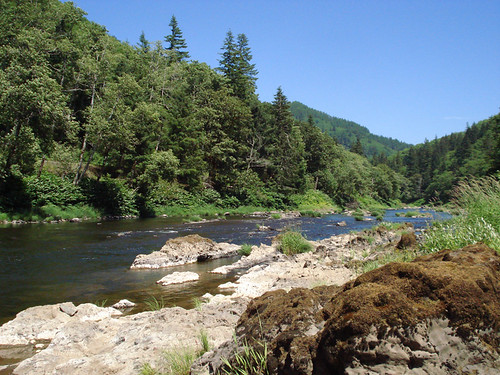
Temperatures were pushing the mid-nineties and A and I were tiring of the nightly, clockwork, 10pm report of our neighbor's pre-4th fireworks. When our friends Kate and Kalin invited us along for a last minute holiday weekend camp-out, we jumped at the chance to skip town. It sounded like fun, until we dug out our tent and camp stove from the crawlspace to find a heavy layer of dust. I guess it's been a while since we've been camping.
In reality, we had little to worry about, since Kalin served as the quartermaster for our college's Semester in the West program. If he could handle two dozen co-eds for 4 months in the rural West, he could probably keep A and I out of trouble for one night in the woods. That is, if we were even able to find a spot to sleep. Most seasoned campers would probably scoff at the 4th of July weekend as a foolhardy time to go camping, but with Kalin's re-assurance, we let go of our anxieties and trusted that if worse came to worse, he would hack through the underbrush to clear us a site.
We drove toward the coast to stop at Nehalem Falls, where we completely lucked out by finding what well may have been the last remaining camp site in all of Oregon. It was small, but totally serviceable, and within earshot and a short walk of the nearby water. We spent a lazy afternoon along the river, counting salamanders, drinking beers, and by turns paddling against and floating with the current. But eventually, we had to eat.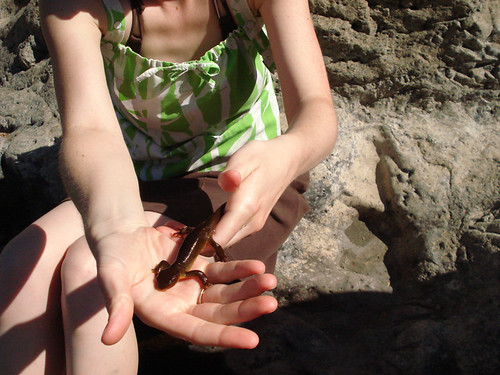
Our friends, wisely assessing the range of our outdoor survival skills, put us in charge of dinner. To prepare, A and I spent a few nights weighing out the merits and challenges of an ongoing list of "simple" foods. Unfortunately, we quickly realized that "home" simple is different that "woods" simple. In fact, a lot of our quick knock-out meals use a lengthy list of pantry and fridge staples, not to mention a bewildering array of pots and pans. If we'd wanted simple, we should have gone with hot dogs. In any event, we had a culinary reputation to maintain, so we settled on a few dishes that we could make with a limited range of camping cookware.
The menu? Penne puttanesca, kale and cherry salad, boozy campfire cheese and, of course, smores. We figured that by mainly using tinned or preserved ingredients (kalamata olives, tuna, anchovies), puttanesca would be easy to transport. To make matters simpler, we pre-cooked all of the noodles so that boiling water wouldn't be a strain on our water supply. The pasta was a good choice, since it tasted just as good once it cools off, which seems to happen quite rapidly when camping. The only hitch we hadn't anticipated was chopping herbs and garlic, but the back of a Rubbermaid tub lid made for a serviceable cutting board.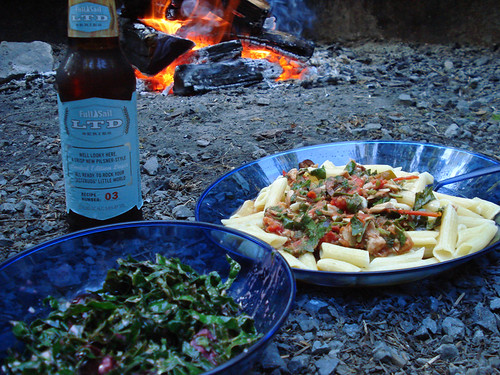
As for the salad, it was our spin on a favorite dish from Dove Vivi. There, they finely shred lacinato kale leaves and toss them with a lemon-and-garlic heavy dressing and shards of ricotta salata. For our purposes, we made a creamy lemon-chevre dressing and threw in a handful of pitted and smashed cherries for a sweet counterpoint. It greatly helped to lightly sauté the kale to take just a bit of the bite off of it (though a longer bath in the dressing would likely accomplish the same thing). I think the salad was so good that we'll probably re-visit it at home; hopefully the taste compares even without the wood smoke.
We were eating well, but we certainly weren't stuffed yet. To fill that what-do-we-eat-now period between dinner and dessert, we took a cue from Chow.com's camp-food article and tried out their campfire cheese. Simply put, douse a wheel of soft-ripened, bloomy-rind cheese with liquor, wrap it in foil, and bury it in the coals. In place of the recommended brandy, we used the bottle of bourbon we had on it. American-made booze for an American holiday. It came out beautifully.
For dessert, smores were an easy choice. What wasn't so easy was talking A out of trying to make her own marshmallows to bring along with artisan chocolate and fresh-baked graham crackers. As much as we care about ingredient provenance, there are some things that just aren't worth messing with. Our only innovation came thanks to Kate and Kalin's telescoping, rotisserie marshmallow skewers. Well-fed, it seems that life in the great outdoors ain't so bad. We hope we earned ourselves a repeat invitation.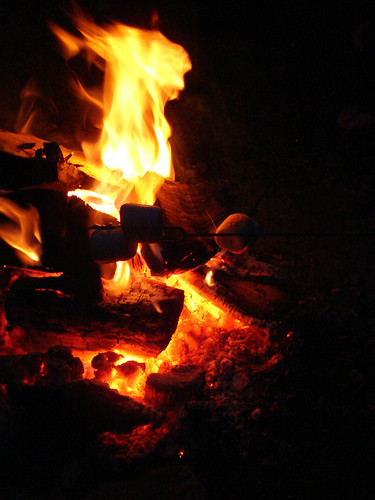
Posted by
p
at
9:24 PM
1 comments
![]()
